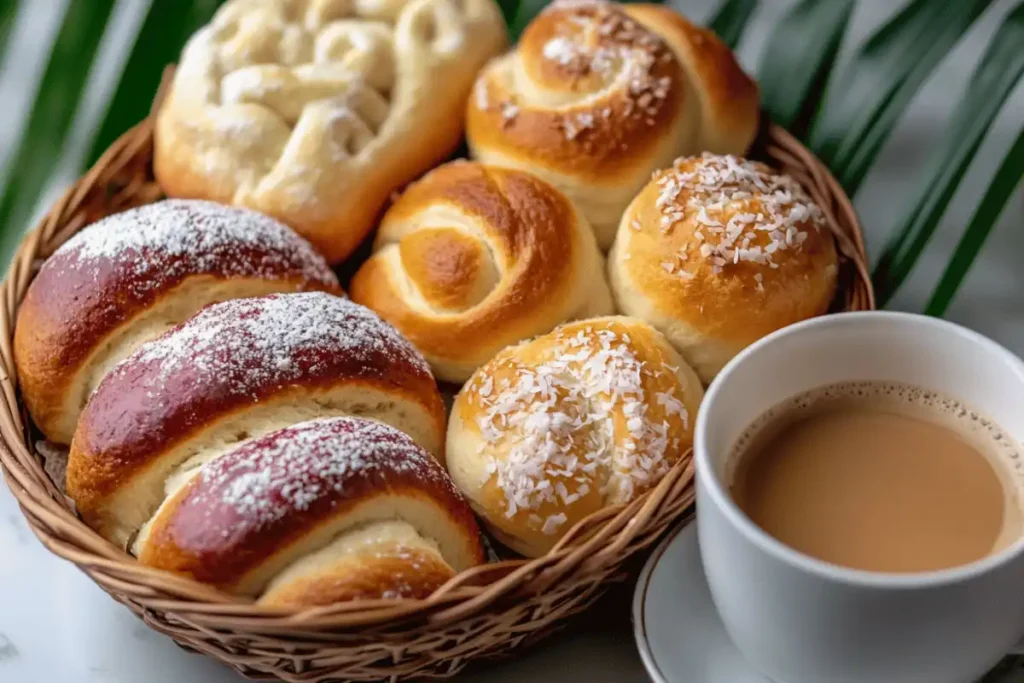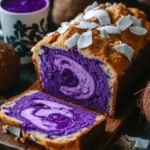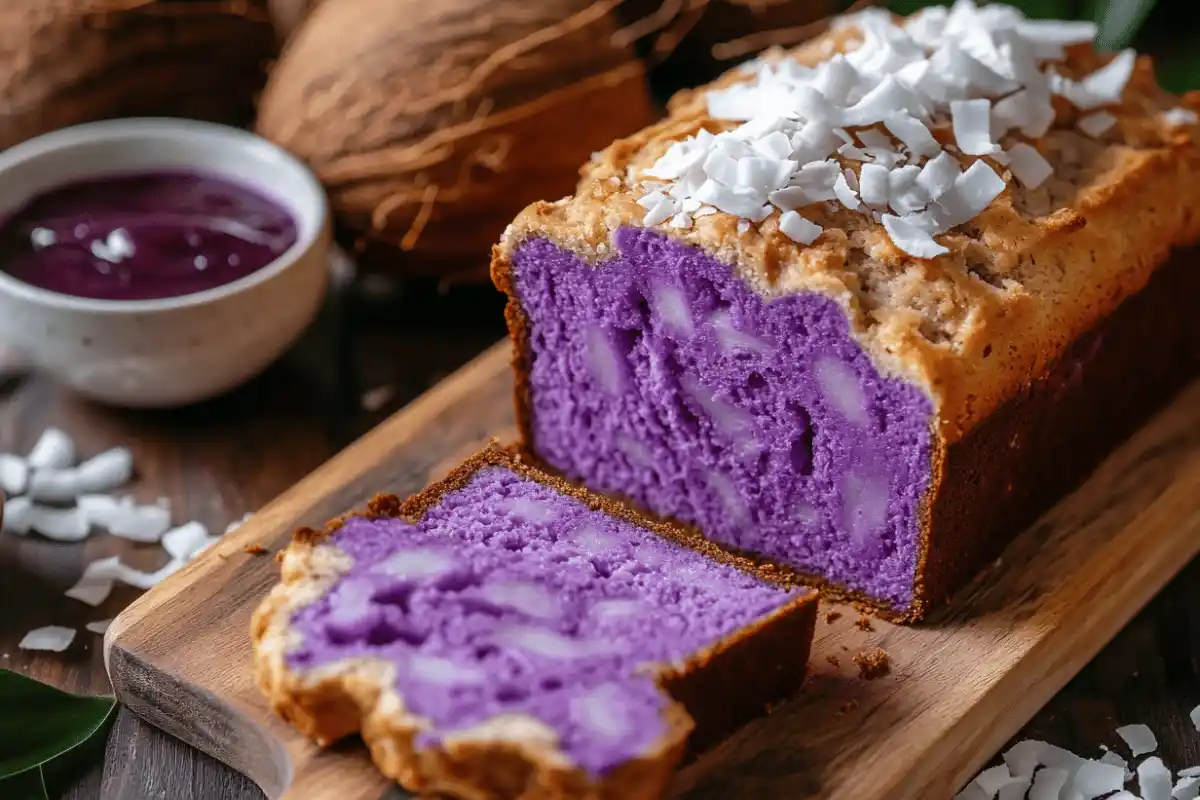Introduction to Coconut Ube Milk Bread
Coconut ube milk bread is gaining popularity in the world of baked goods for its unique combination of tropical flavors and the comforting texture of soft bread. This delightful creation blends the nutty sweetness of coconut, the vibrant, earthy flavor of ube, and the creamy richness of milk in a harmonious loaf. Its eye-catching purple hue and exotic taste have made it a favorite among both home bakers and professionals, especially those exploring global baking trends.
But what exactly is coconut ube milk bread, and why has it become so popular? Let’s explore its origins, ingredients, and how you can make this masterpiece at home.
Table of contents
What Is Coconut Ube Milk Bread?
Soft Ube Coconut Bread is an enriched bread that combines the tropical flavors of coconut with the vibrant taste of ube, or purple yam. This bread has a soft, fluffy texture, a striking purple color from the ube, and a subtle coconut aroma with creamy undertones from the milk.
Moreover, ube desserts have long been staples in Filipino cuisine. Recently, this bread has gained international recognition, particularly for its unique blend of traditional Asian ingredients and Western baking techniques. From breakfast to dessert, Ube-Flavored Coconut Bread can be enjoyed at any time of day thanks to its versatility and irresistible flavor.
The Unique Ingredients
The secret to Ube-Flavored Coconut Bread lies in its carefully selected ingredients. Furthermore, each ingredient contributes significantly to its flavor and texture.
Ube (Purple Yam): This vibrant purple root vegetable has a naturally sweet, nutty flavor. Specifically, ube is visually appealing and rich in antioxidants.
Coconut Milk or Cream: Coconut adds a rich, tropical aroma. Additionally, its natural fats contribute to the bread’s tenderness and moistness.
Milk: Milk creates a soft, tender crumb and a creamy sweetness.
Butter or Oil: These fats help create a fluffy texture and add richness.
Sweeteners (Sugar or Condensed Milk): These enhance the natural flavors of coconut and ube.
The Origins of Ube in Baking
Ube has a long history in Filipino cooking. It’s commonly used in desserts like ube halaya, cakes, and pastries. Its unique color and flavor have gained recognition internationally, as bakers introduce global audiences to Filipino cuisine.
Incorporating ube into bread represents a fusion of traditional Filipino flavors with modern baking. Consequently, combining ube with coconut and milk was a natural evolution, as these ingredients often appear together in Filipino desserts like bibingka and puto.
Why Coconut Enhances the Recipe
Coconut is a standout ingredient in coconut ube milk bread for several reasons. Its nutty and slightly sweet taste pairs beautifully with the earthiness of ube. Additionally, coconut milk or cream adds a luxurious richness, making the bread soft and moist. Coconut contains healthy fats, vitamins, and minerals that contribute to overall wellness, elevating the bread into a tropical delight.
Health Benefits
Milk Bread with Ube and Coconut offers several health benefits thanks to its wholesome ingredients. Notably, it is rich in nutrients that support overall well-being.
Rich in Antioxidants: Ube is packed with anthocyanins, powerful antioxidants that help combat free radicals and reduce inflammation.
Source of Healthy Fats: Coconut milk and cream provide medium-chain triglycerides (MCTs), which offer quick energy and support brain health.
Vitamins and Minerals: This bread contains essential vitamins like Vitamin C from ube, calcium from milk, and iron from enriched flour, supporting bone health, immune function, and overall vitality.
Naturally Sweetened Variations: You can use natural sweeteners like honey or coconut sugar for a healthier version without compromising flavor.
How to Make Coconut Ube Milk Bread at Home

Creating coconut ube milk bread at home is a rewarding experience. Thus, it allows you to enjoy this delicacy fresh from the oven.
Ingredients Breakdown:
Flour: Bread flour for a chewy, fluffy texture.
Ube: Freshly cooked and mashed ube or ube powder/paste.
Coconut Milk: Full-fat coconut milk for a creamy texture.
Milk: Warm whole milk to activate the yeast and add richness.
Butter: Unsalted butter for a tender crumb.
Yeast: Active dry yeast or instant yeast.
Sugar: Granulated sugar or coconut sugar for sweetness.
Salt: Enhances flavor and balances sweetness.
Preparation Process:
Activate the Yeast: Combine warm milk (about 110°F) with a teaspoon of sugar and yeast. Let it sit for 5-10 minutes until foamy.
Mix the Dough: Combine flour, mashed ube, sugar, coconut milk, and the yeast mixture in a large bowl. Knead until the dough forms. Add butter and knead until smooth and elastic.
First Rise: Cover the dough with a damp cloth and let it rise in a warm place for 1-2 hours or until it doubles in size.
Shape the Dough: Punch down the dough, roll it out, and shape it as desired—either as a loaf, braided bread, or individual rolls.
Second Rise: Place the shaped dough into a greased pan and let it rise again for 30-45 minutes.
Bake: Preheat the oven to 350°F (175°C). Bake the bread for 25-30 minutes or until golden brown.
Cool and Serve: Let the bread cool completely before slicing. Enjoy as is or with butter or ube halaya.
Popular Variations

While the classic loaf is a favorite, nevertheless, bakers love experimenting with coconut ube milk bread to create exciting variations.
Braided Loaf: Braid three strands of dough, often filled with ube halaya or sweetened coconut flakes, for a visually stunning loaf.
Stuffed Rolls: Fill individual rolls with ube jam or coconut custard for a portable and satisfying snack.
Swirled Bread: Layer ube and coconut fillings in rolled dough to create a mesmerizing swirl pattern.
Glazed Toppings: Drizzle the bread with a coconut glaze or sprinkle with desiccated coconut for added sweetness and texture.
These variations showcase the versatility of coconut ube milk bread and offer new ways to enjoy its delightful flavors.
Common Mistakes and Troubleshooting
Even experienced bakers can encounter challenges when making coconut ube milk bread. Therefore, here are common pitfalls and how to avoid them:
Dense or Tough Bread: Over-kneading the dough or using too much flour can make the bread dense. Knead only until the dough is elastic and smooth.
Uneven Baking: Bread that’s raw in the middle may result from an oven that’s too hot or incorrect pan placement. Use an oven thermometer to ensure consistent temperatures.
Dry Bread: Insufficient moisture can lead to dry bread. Measure liquid ingredients carefully and avoid over-baking.
Flat Loaf: Bread that fails to rise properly is often due to old yeast or a cold proofing environment. Always check the expiration date on your yeast and proof in a warm area.
Where to Buy Coconut Ube Milk Bread
If baking isn’t your forte or you’re looking for convenience, alternatively, you can easily find coconut ube milk bread from specialty bakeries and online stores.
Local Bakeries: Many Asian or Filipino bakeries offer coconut ube milk bread as part of their menu, often using authentic ingredients and traditional techniques.
Farmer’s Markets: Some farmer’s markets feature artisanal bakers who specialize in unique bread varieties, including coconut ube milk bread.
Online Stores: Websites like Etsy or dedicated baking platforms often have bakers selling coconut ube milk bread, with many offering nationwide shipping.
Grocery Stores: Large grocery chains with international sections may stock coconut ube milk bread, especially in areas with a sizable Filipino community.
The Cultural Significance of Ube Desserts
Ube holds a special place in Filipino culture. In particular, it symbolizes comfort and indulgence. As a staple crop, ube has been used in traditional desserts for generations, often served during celebrations and family gatherings.
A Culinary Staple: Filipino cuisine is rich in flavors and textures, and ube is a cornerstone ingredient in many beloved recipes. From ube halaya (sweetened yam spread) to cakes and ice cream, it has long been cherished for its versatility.
Global Popularity: Thanks to social media, ube has become a global sensation. Its vibrant purple color and exotic flavor make it a favorite for food bloggers and chefs, propelling Filipino desserts, including coconut ube milk bread, into the international spotlight.
Pairing Coconut Ube Milk Bread with Beverages
Pairing Ube-Flavored Coconut Bread with the right beverage can elevate the experience. As a result, here are some suggestions to complement the flavors:
Coffee: The robust flavor of coffee complements the sweetness of the bread, making it perfect for breakfast or an afternoon treat.
Tea: Light teas like chamomile or green tea pair well with the bread’s rich flavors without overpowering them.
Hot Chocolate: For a decadent pairing, enjoy coconut ube milk bread with a cup of creamy hot chocolate.
Tropical Drinks: Enhance the bread’s tropical vibe with coconut water, mango smoothies, or iced ube lattes.
Preserving and Storing
To maintain its freshness and flavor, consequently, coconut ube milk bread should be stored properly.
Short-Term Storage: Wrap the bread in plastic wrap or foil and keep it at room temperature for up to three days.
Refrigeration: For longer storage, place the bread in an airtight container and refrigerate it. Reheat slices in the microwave or toaster for freshness.
Freezing: Wrap the bread in plastic and place it in a freezer bag. It can be frozen for up to three months. When ready to eat, thaw at room temperature and warm in the oven.
Customer Reviews and Experiences
Ube-Flavored Coconut Bread has received rave reviews from food enthusiasts worldwide. Indeed, here’s what people are saying:
“The perfect balance of sweetness and fluffiness!” Customers love the bread’s soft texture and delightful combination of coconut and ube flavors.
“A visual and culinary masterpiece.” The striking purple color is often highlighted as a standout feature, making it as beautiful as it is delicious.
“Great for sharing and gifting.” Whether purchased or baked at home, coconut ube milk bread is praised as an ideal gift for friends and family, particularly during holidays and special occasions.
FAQs
What is the best way to store coconut ube milk bread? Store it in an airtight container at room temperature for up to three days or freeze it for longer preservation.
Can I use fresh ube instead of ube powder? Yes, fresh ube can be steamed, mashed, and used in place of ube powder or paste for a more authentic flavor.
Is coconut ube milk bread gluten-free? Traditional recipes use bread flour, which contains gluten. However, gluten-free variations can be made using alternative flours like almond or rice flour.
What beverages pair well with coconut ube milk bread? Coffee, tea, hot chocolate, and tropical drinks like coconut water or iced ube lattes complement the flavors beautifully.
Can I make this bread without coconut? While coconut enhances the flavor, it can be omitted or replaced with almond milk for a different twist.
Why is my bread dense and not fluffy? Dense bread can result from under-proofing, over-kneading, or using too much flour. Ensure proper proofing and accurate measurements for the best results.
Conclusion
Coconut ube milk bread is more than just a loaf; it’s a culinary journey that combines tropical flavors, cultural heritage, and modern baking techniques. Whether enjoyed fresh from the oven, purchased from a bakery, or gifted to loved ones, this vibrant purple bread is sure to leave a lasting impression. With its growing popularity, now is the perfect time to try your hand at baking or tasting this exotic delight.
Print
Tropical Coconut Ube Milk Bread
- Total Time: 2 hrs 30 mins (including rising)
- Yield: 1 loaf (10 slices) 1x
Description
Soft, fluffy, and rich with tropical flavors, this Coconut Ube Milk Bread blends creamy coconut milk and vibrant purple yam for an eye-catching and delicious loaf. Perfect for breakfast, brunch, or dessert, it’s a sweet, tender bread with a beautiful swirl of color and nutrients.
Ingredients
-
3 cups bread flour
-
1 cup mashed ube (or ½ cup ube halaya)
-
¾ cup full-fat coconut milk
-
½ cup warm milk (around 110°F)
-
¼ cup sugar (or coconut sugar)
-
4 tablespoons unsalted butter
-
2 ¼ tsp active dry yeast (1 packet)
-
1 tsp salt
Instructions
-
Activate Yeast: Mix warm milk with a teaspoon of sugar and yeast. Let it foam (5–10 minutes).
-
Make Dough: In a bowl, combine flour, ube, sugar, salt, coconut milk, and the yeast mixture. Mix until shaggy.
-
Knead & Butter: Knead the dough, adding softened butter gradually. Continue kneading until smooth and elastic.
-
First Rise: Cover and let it rise for 1–2 hours in a warm place.
-
Shape Dough: Punch down, shape into a loaf or rolls.
-
Second Rise: Let rise again for 30–45 minutes in pan.
-
Bake: Preheat oven to 350°F (175°C). Bake for 25–30 minutes until golden.
-
Cool & Serve: Let cool before slicing. Enjoy with butter, jam, or tea!
Notes
-
Use ube halaya for a sweeter, denser loaf.
-
Swirl coconut flakes into the dough for extra texture.
-
Best enjoyed within 3 days or frozen for later.
- Prep Time: 20 mins
- Cook Time: 30 mins
- Category: Breads
- Method: Baked
- Cuisine: Filipino / Fusion
Nutrition
- Serving Size: 1 slice (about 65g)
- Calories: 210 kcal
- Sugar: 7g
- Sodium: 180mg
- Fat: 7g
- Saturated Fat: 5g
- Unsaturated Fat: 2g
- Carbohydrates: 30g
- Fiber: 1g
- Protein: 4g
- Cholesterol: 15mg
Keywords: ube bread, coconut milk bread, Filipino bread recipe, purple yam bread, dairy-free bread option, tropical bread recipe
